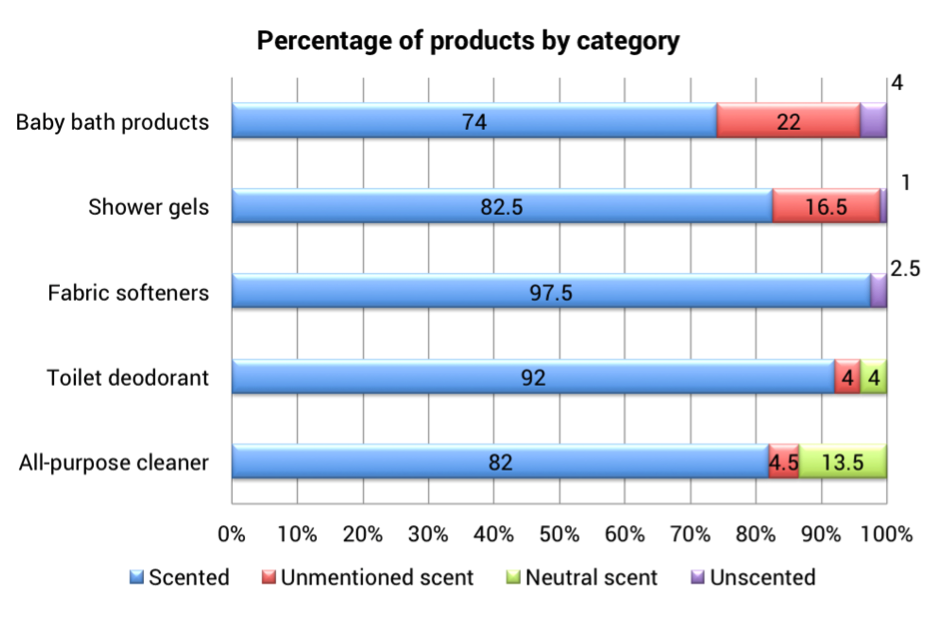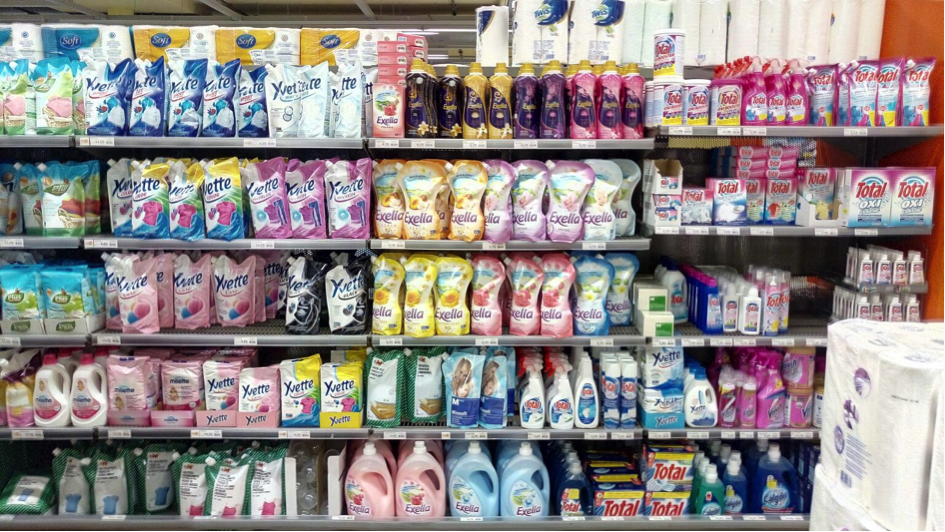Sensory and scent-marketing highlight how the sense of smell affects our everyday purchasing decisions. Accordingly, one expects an abundance of scented products in contemporary consumer culture. Yet, we can also witness an increasing awareness of multiple chemical sensitivities that might promote an opposite trend. This is the commercial context of a recent thesis submitted in the BBA International Program at Bern University of Applied Sciences by Jennifer Zwyer and supervised by Claus Noppeney: How prevalent is the sense of smell in today’s consumer culture? How prevalent are scented products on the shelf in supermarkets today? How openly is the olfactory status communicated to the consumer? Verbally? Visually?
In response, a total of 270 products out of 6 product categories on the shelf at the leading Swiss retailer Migros were analyzed. The sample covers all products of the selected categories that are available through the Migros online presence “Le Shop“. The product categories range from all-purpose cleaners to baby bath products, and additionally cat food.
To our surprise there is no cat food in the sample (i.e. available through the Migros online store) that explicitly mentions its olfactory qualities though consumers heavily discuss the smell of cat food. Why does no brand or product in our rather representative sample respond to these concerns? We do not know yet.
For the other product categories scent can be considered as a secondary product attribute. The products are analyzed with respect to various criteria (e.g. packaging, color of packaging, wording on the packaging, and references to scent). Analyzing the sample, five distinct scent categories are identified: clearly scented, undefined scent, scent not mentioned, neutral scent, and unscented. The categorization is based on the information disclosed on the product. The distribution across the five product categories is summarized in a table:

Out of 22 all-purpose cleaners 82% are scented. Only one product does not mention scent at all, 3 products claim to have a neutral scent, and there is no scent free product in this category. The primary purpose of these products is to clean and disinfect surfaces or objects. The abundance of scented products demonstrates the relevance of the sense of smell for our concept of cleanliness. Most products describe their scent as “freshâ€. Worldwide the scent of lemon or other citrus fruits is commonly perceived as fresh. Consequently, it is also the most used scent in this category.
With respect to toilet deodorants it is surprising that one product does not even mention scent and one product claims to be scent neutral. Since smells are removed through masking it remains open what olfactory neutrality really means in the context of a toilet deodorant! Three products mention chlorine as the scent used – isn’t this a surprisingly technical interpretation of cleanliness in a private home?
Out of 39 fabric softeners only one product is promoted as scent free. Moreover, a number of products even promise a longer lasting scent to their customers (e.g. “up to 8 weeksâ€). In fact, it is telling that no softener is offered as scent free. What follows from this? Softeners are basically about scent. The experience of softness is above all an olfactory experience. And sensitive people do not use softeners.
Shower gels are an interesting category for a number of reasons. Surprisingly, only one product is marketed as scent free. Moreover, 16.5% of all shower gels are silent about the olfactory status of the product. Yet, a number of these products explicitly target specific caring and nurturing needs. Whereas numerous products appeal to male users, only one product describes its scent as “feminineâ€. Another striking gender difference: On the one hand, 60% of the products that explicitly target male users do not define the scent. On the other hand, only 16% of the unisex shower gels do not clarify the scent of the shower gel. In other words, it is important that a shower gel targeted at male users is scented. Yet, it is not important how it is scented. This figure illustrates that the “Axe effect†established by one of the most sexist advertising campaigns works even today.
Out of 27 baby bath products 74% are scented, 6 products do not even address the olfactory status and once again only one product is promoted as scent free – another surprising result.
In conclusion, scent is definitely present on the supermarket shelf. And depending on the product category the olfactory status of a product is also made explicit. All in all, the olfactory status is worth talking about. It matters whether a product is scented or not. The recent study clarifies this bold statement for a set of selected product categories in the Swiss market. However, the study does not question the information disclosed on the product as a dermatologist can do in response to MCS concerns. Lacking any economic data (e.g. sales) the analysis may seem incomplete. Yet, it shows how differently scent is communicated to the consumer. It differs even between product categories that all in all respond to similar consumer needs (i.e. cleanliness). Given the very limited number of openly scent free products, there are also neglected business opportunities in the Swiss market. In fact, Wal-Mart’s online grocery service lists as of today 30,650 products labeled “scented†in total versus 4,371 products labeled “unscented“. This amounts to a 7:1 ratio (slightly below the ratio on Amazon.com: 7.5:1). Is this high? Is this low? And how will this ratio be in the future? We do not know for sure. But, in a world that is increasingly designed with an appeal to multiple senses consumers expect information on the olfactory status of a product. Moreover, knowing how polarizing a scent can be it is very likely that for many scented products there is also demand for an unscented option.
Zwyer, Jennifer: Scent in everyday consumer culture. Typology of using the sense of smell in ordinary supermarkets. Bern: Bachelor-Thesis Berner Fachhochschule, Fachbereich Wirtschaft, 2016
[blog_subscription_form title=”” title_following=”You are already subscribed” subscribe_text=”” subscribe_logged_in=”Click to subscribe to this site” subscribe_button=”Click me!” show_subscribers_total=true]
